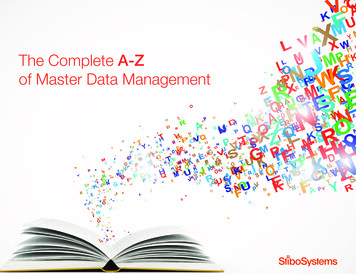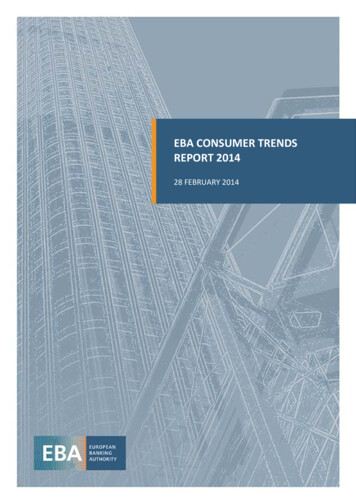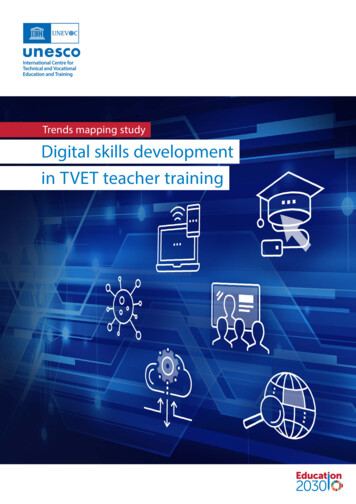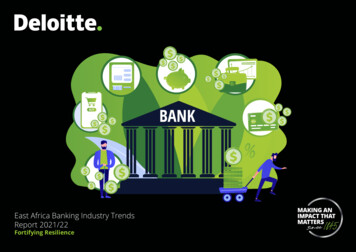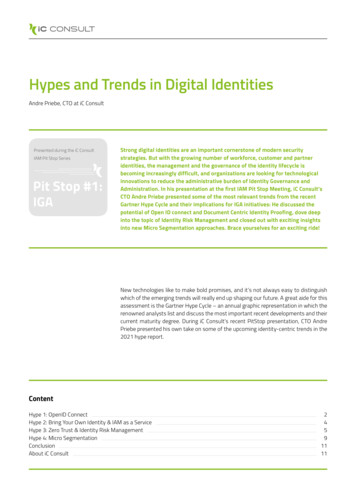
Transcription
Hypes and Trends in Digital IdentitiesAndre Priebe, CTO at iC ConsultPresented during the iC ConsultIAM Pit Stop SeriesPit Stop #1:IGAStrong digital identities are an important cornerstone of modern securitystrategies. But with the growing number of workforce, customer and partneridentities, the management and the governance of the identity lifecycle isbecoming increasingly difficult, and organizations are looking for technologicalinnovations to reduce the administrative burden of Identity Governance andAdministration. In his presentation at the first IAM Pit Stop Meeting, iC Consult’sCTO Andre Priebe presented some of the most relevant trends from the recentGartner Hype Cycle and their implications for IGA initiatives: He discussed thepotential of Open ID connect and Document Centric Identity Proofing, dove deepinto the topic of Identity Risk Management and closed out with exciting insightsinto new Micro Segmentation approaches. Brace yourselves for an exciting ride!New technologies like to make bold promises, and it’s not always easy to distinguishwhich of the emerging trends will really end up shaping our future. A great aide for thisassessment is the Gartner Hype Cycle – an annual graphic representation in which therenowned analysts list and discuss the most important recent developments and theircurrent maturity degree. During iC Consult’s recent PitStop presentation, CTO AndrePriebe presented his own take on some of the upcoming identity-centric trends in the2021 hype report.ContentHype 1: OpenID ConnectHype 2: Bring Your Own Identity & IAM as a ServiceHype 3: Zero Trust & Identity Risk ManagementHype 4: Micro SegmentationConclusionAbout iC Consult24591111
Identity and Access Management Hype Cycle 2021Time To Plateau Will Be Reached: 2 yrs.2-5 yrs.5-10 yr.Decentralized IdentityMachine Identity ManagementSMPCMobile MFAExpectationsloT AuthenticationZero-Knowledge ProofsBiometric AuthenticationMethodsOAuth 2.0lAM ManagedServicesFIDOSCIMAPI Access ControlBring Your Own IdentityUser-Managed AccessCIEMSaaS-Del iveredlAMEDRMPrivileged AccessManagementDCIPCustomer lAMEAMOpen IDConnectInnovationTriggerPeak of InflatedExpectationsTrough ofDisillusionmentAs of July 2021Slope ofEnlightenmentPlateau ofProductivityTimeHype 1: OpenID ConnectWhy is OpenID Connect – which is not exactly a new technology – suddenly so relevant?Identity proofing is not exactly a new topic. All of us have been implementing andleveraging the identity proofing technologies for many years. But recently, there hasbeen a major paradigm change: We see that the responsibility to manage the proofingprocesses is rapidly shifting away from single business applications to a centralizedidentity access management system. This should come as no surprise: Typically,enterprises have to spend a lot of money to get an identity verified by an organization.Being able to use this information and this valuable data multiple times can savecompanies a lot of money. And what’s even more important: It significantly improvesusability.Apart from that, there are other good reasons to consolidate identity proofing in acentral spot: The first that comes to mind is regulations – but frankly, most of thesehave been out for years. Another reason is that identity fraud is increasing – and notjust for customers but also with multiple attacks on the supply chain. A third factor isthat the number of fully AI-based solutions for the verification of documented identityinformation is increasing. Everything is becoming more efficient, usability is improvingand everybody‘s getting to know these solutions.So, there are multiple good reasons why companies are looking into centralized IAMsolutions, and a side effect of this is that a lot of things are happening around theOpenID protocol. This is still just in specification but already on a level where werecommend having a closer look.
The core idea is to enhance the information shared by OpenID Connect with a verifiedclaims object which could provide additional information about which trust frameworkhas been used. This will probably include: which rules have been used for the validation process – for example, specificmoney laundering laws or telecommunication laws; detailed information about the verification method that has been used:Was it physical, e.g., an in-person check at a point of sale or by an agent?Or was it unsupervised and remote – e.g., via an app scanning the document?Or was it by leveraging the electronic functions of the ID card? which organization was in control of the verification process; and which document has been used for that purpose, including its expiry date anda definition of the parameters you want to share.OpenID Connect for IdentityAssurance 1.0Example of Standard Methods Physical In-Person Online electronic ID card Unsupervised remote video {“verifled claims“ : {“verification“ : {“Trust framework“ : “ial example gold“ ,“evidence“ : [{“type“ : “id document“ ,“method“ : “pipp“ ,“time“ : “2019-04-22T11 :30Z“ ,“verifier“ : {“organization“ : “National Post“ } ,“document“ : {“type“ : “idcard“ ,“Date of expiry“ : “2021-03-22“ }} ] }“claims“ : {“given name“ : “Max“ ,“family name“ : “Maxwell“} }}How verified?Evidence?Example of Standard Documents ID Card Passport Example of StandardFrameworks German Anti-MoneyLaundering Law German Telekom muni ca tions Law Which Rules? EU regulation eIDAS for When verified?Substantial and High Who verified? Japanse residence cardfor foreigners Source: openid.net / eKYC & IdentityAssurance Working Group Published: 6 Sep. 2021 Status: 3rd Implementer‘s DraftThis specification is already more or less final, and we are expecting only a few lastadaptions. This is exciting news: OpenID Connect is promising to make it much moreefficient to share identity-centric information within your organization. The big plusis that you will not have to take care of the solution design anymore and can simplyleverage the existing specifications.Note that this aspect is also becoming more important in B2B scenarios as well as inworkforce scenarios where we cannot be 100% sure about identity anymore. This isespecially important as a lot of people worldwide have been working remotely for twoyears now, and that’s really driving the demand for strong identities.
Hype 2: Bring Your Own Identity & IAM as a ServiceOrganizations are often struggling when applying their IGA processes to external users.How can new technologies help us make those more efficient?This is another big topic which has spawned several entries in the Gartner assessment.In this context, we ought to look at two major hypes: Bring Your Own Identity andIAM as a Service. In both of these realms, Microsoft is quickly becoming one of themore important players, and for good reasons, because they deliver identity as wellas rich business functionality. A lot of our clients have already migrated to Microsoft365, but their identities have not yet been perfectly integrated. Or maybe they havebeen integrated but they are also thinking about implementing additional interestingcapabilities and features. How can we leverage that – together with our identity accessmanagement we already have in place – especially with regards to B2B applications.So how does our typical IAM architecture look like today? Usually, an identity providertakes care of authentication, authorization, SSO, MFA and similar things. In addition, wehave IGA, which is taking care of the identity lifecycle, the roles, processes to provideprivileges and so on. And all of this is not only needed for our employees but also for allother digital identities accessing our IT systems. This includes partners and suppliers,external sales organizations or even customers. Combining all of these moving parts inone comprehensive solution is becoming more and more difficult.Enter Microsoft 365 with its huge footprint. They have a very compelling offering,especially with regards to Active Directory. Why? Well, Microsoft has to provide andmanage strong digital identities for many of their solutions already – including emailaccounts, shared documents and many other capabilities like the collaboration inMicrosoft Teams. And they are doing a great job not just for internal teams but alsowhen it comes to integrating external accounts like customers or suppliers.One of the most exciting features in this context is “Guest Invite,” which allows users toinvite guests or team members based on policies to collaborate in a very, very efficientway. Now note that this is usually targeting the same people who are already in yourpartner or supplier identity repositories, your database directories, or other directories.So, when you are inviting guests into your working space, you will usually use theirexternal email address – and that email address is often already known to Microsoft,because the invitees are also using Microsoft 365 in some way, shape or form. This isthe foundation for a very innovative feature, which comes for free with your Microsofttenant: the Federation. It‘s waiting there for you, ready to connect you at scale withthousands of enterprises, provided you are already operating with these companies.B2B Identities and MicrosoftAzure AD Your IAM3 Party IdP IdentityProviderBusinessApplicationsIGArd(e.g. Google,Apple, LinkedIn, )EmployeesPartner &SuppliersMicrosoft Azure Azure AD Your Tenant Azure AD ArbitraryTenant MS 365Application
That said, there is still one major challenge, and that’s the lack of a central authorizationto define what access an external person has within your organization. We will have tofind a way to integrate Microsoft Azure and IGA tools in order: to understand what kind of guests are out there to stay in control of the process required to invite guests to be able to proof identities for these guests; and to have a clear understanding of what kind of guests we want to allowand what rules we needAll of that boils down to one question: What kind of Federation partnership do wewant to have? I really recommend our customers to discuss this with knowledgeableexperts. Microsoft Azure is a very powerful tool. It offers a wide set of features andgrants a lot of flexibility for your integrations. But it can also be a bit overwhelmingat first, so you really need to address the topic. Otherwise, you will have no controlwhatsoever over what is happening with external identities on MS365.Note that due to the huge amount of features and configuration options, you will rarelyhave full visibility of your identities right from the start. Also, Microsoft and ActiveDirectory capabilities are developing rapidly, with new features being added all thetime. So, the whole ecosystem is very complex but also very dynamic and that is, ofcourse, a good thing – but not without challenges.Hype 3: Zero Trust & Identity Risk ManagementWhat is Zero Trust – and do we really need it?Another huge topic, which has already made it safely into the late phases of the GartnerHype Cycle is Zero Trust. The core idea of Zero Trust is very simple. Let’s look at ascenario where one of your end users wants to access some resource via his notebook.In the past, he had to gain access to the network first. But once he was inside, he foundhimself in a large zone of implicit trust, where the resources were not necessarilyunprotected but definitely not protected well enough to expose them to the Internet.Zero Trust Architecture High Level OverviewCDMSystemIndustryCompliance 1. Authentication 2. Authorization ThreatIntelligence AcitivityLogs Source: NIST Special Publication 800-207,Aug. 2020 DataAccessPolicy Policy DecisionPoint UntrustedZone PolicyEnforcementPoint PKIIDMImplicitTrust Zone SIEMSystem
Now, the core idea of Zero Trust is to make this zone of implicit trust as small aspossible and the untrusted zone as large as possible.In the example above, this would mean having a policy enforcement point right beforethe resource the employee is accessing – basically: a spot where we will authenticateand authorize him. The next step will be to collect as much information about himas possible to allow for a robust authorization decision. Having a dedicated set ofevaluation policies before every single resource will make it much harder for anyattacker to move through your network or to jump from one compromised systemto the next. That said, there are a couple of challenges when implementing thisapproach.Challenge 1: Complex Policy ManagementA big one is policy management, which is getting more and more sophisticated.Nowadays, most companies want to check, for example, what kind of mobile devicea user is connecting with, before letting them access any information or to includedynamic threat intelligence in their decision making. All of this requires very smartframeworks. Another challenge is that you need to understand both sides and allimplications of the decision-making process very well and need to comprehend boththe technical and the business implications of your policies: If you start blocking noncompliant devices from accessing your network, this might heavily affect partners,suppliers and customers and is not a decision that should be made lightly. So, policymanagement can be a challenging task. It can cause ripples across multiple businessprocesses and applications, and it depends strongly on your organization’s risk appetite.Challenge 2: Managing Policy Enforcement PointsThe second key challenge is the policy enforcement point. While some vendors positionthemselves as full-scale providers for all things Zero Trust and claim to offer a fullyintegrated solution, that is not always the whole picture. The policy enforcement pointis not a simple device but rather a complex concept: It needs access to all resources,has to speak and understand multiple protocols and different architectures and beable to interact with a vast array of different technologies – all while being tailored toprotect that one specific resource. That’s very hard.Challenge 3: Lack of VisibilityBut there’s an even bigger issue: We can only protect what we see. We have to knowit exists, because otherwise we won’t even know that we have to put an enforcementpoint in front of it. This is something we have to focus on: How can we get full visibilityof what is out there? How can we protect it? How will we know if there are changes orif new resources get added somewhere in the cloud?This takes us straight to the next point when talking about your Zero Trust architectures:You have to make sure that these activities are really covering all your critical assets –even if that critical asset is an Excel sheet that should not even exist, with account andpassword information that could compromise hundreds of companies. But what canwe do to ensure that our Zero Trust architecture achieves this goal?The Solution: Comprehensive Identity Risk ManagementTo illustrate how to establish this kind of protection, let’s have a look at the state ofidentity risk management today, why it is so important and which recent developmentsyou can leverage to improve your organization’s posture. We will look at the risk ofaccount takeovers as an example.
I think we all agree that in a large organization, account takeovers will occur.By default, the probability that the incident will happen is probably close toa hundred percent. Estimating the impact of such a takeover, on the other hand, is much harder.It depends on the tools and goals of the attacker and can vary a lot.To reduce the risk potential for your company, there are two routes you can take: Some activities – e.g., introducing multi-factor authentication – will significantlydecrease the likelihood of a successful takeover. Other activities can decrease the negative impact of a successful takeover.Zero Trust is a good example here: As long as you ensure that least privilegeprinciples are applied in your network, this will significantly decrease the riskof lateral movement and limit the damage the attacker can cause.Also, for both of these routes, there are several exciting new approaches that canhelp you mitigate risk even further. And while the following is not intended to be acomprehensive guide, it should help you understand how you can combine differentprocedures and technologies to minimize the risk of a truly devastating attack and tunethe risk level so that it perfectly matches your organization’s risk appetite.Identity Risk Management InternalStaticDynamicIdentityRisk Scoring(Role-based) IdentityRisk Discovering(attack-surface) ExternalIdentity ThreatMonitoring Cloud InfrastructureEntitlement Mgt. If we are looking to control our risks, our first step will usually be to figure out whichusers we have to pay most attention to. The traditional way to identify them is anIdentity Risk Scoring (IRS) based on your IGA framework: To achieve this, you have togain a robust understanding of the critical roles in your organization and the differentroles every specific user holds. Based on that, it is easy to locate the 10% or 20% mostcritical users in your company and to implement additional layers of protection forthem – e. g., by providing each of them with an impersonation resistant, hardwarebased authenticator.
Another fairly new dynamic and sophisticated Risk Management approach is to analyzethe tech surface from an attacker’s perspective. There are some very smart tools outthere today, which allow you to analyze the path an attacker could take when movingthrough your network. With these tools, you can look for hazardous files on notebooks,analyze connections, look where critical credentials are stored and get a very goodidea of where your most critical systems and your privileged users are located. Thisapproach is called Identity Risk Discovery, and it is a great starting point if you want toenforce an especially strict authentication for this set of accounts. A secondary benefitof this attack path analysis is that it will very likely make you aware of multiple highrisk accounts, which weren’t on your original list. A good example are accounts whichare used to authenticate to database accounts and usually have privileged access tothis database; or local accounts with administrative privileges, which can escalate togain additional administrative privileges.A third important consideration in this space is the idea of Identity Threat Monitoring(ITM). Unlike traditional threat monitoring – which analyzes potential exploits an attackermight use to infiltrate your organization – ITM adds an interesting new twist: It focuseson the specific threats that target your identities, as identities are quickly becoming thenew perimeter in a Zero Trust world. If you analyze the Threat Monitoring market, youwill find more and more new solutions on the market focusing on the monitoring ofidentities, and those can be a very valuable tool to reduce the likelihood of an identitybased breach, e. g., via stolen or compromised passwords.Our final hype entry in the Identity Risk Management space is Cloud InfrastructureEntitlement Management, or CIEM. If we have another look at the Gartner Hype Cycle,you can see it’s a very new entry, and Gartner claims it will be five to ten years untilthis technology reaches its Plateau of Productivity. If you ask me, I think this estimateis a bit on the long side. CIEM will happen way faster. There are already some reallysophisticated solutions available, which are very good at analyzing what resources arelocated in the cloud and which accounts and privileges can access them. Gaining thiskind of visibility is becoming more and more important, and these tools are gettinga lot of attention already. Another interesting aspect is that Microsoft is investingheavily into CIEM technology, and it will definitely become a key component for notonly Microsoft Azure but also AWS and GCP resources. This really underscores theimportance of the topic: A lot of enterprises are concerned with the lack of visibility andtransparency they are experiencing right now. It has become so easy to add anotherfast service to your infrastructure – but obviously, whenever this happens, it introducesadditional risks. CIEM promises to solve or at least alleviate this problem and will be animportant cornerstone of future architectures.And with that, let‘s return to the starting point of our analysis, the topic of identityrisk management. If we combine the traditional and the new tools we discussed, wecan significantly decrease the likelihood of a critical account takeover, because weknow which accounts to focus on and can provide strong authentication and especiallyrobust policies for these accounts. And we can also use these tools to decrease theimpact of a successful attack.And another aspect needs to be considered: As we have learned, some resources arenot protected by our policy enforcement points so far – either because we are notaware of them or because we cannot cover them from a protocol perspective. Thismeans we have to find different solutions for these vectors, and I will touch on someof these approaches next.
One such approach is not to put anything directly into the stream between the clientand the resource, as the resource is a Windows file-share. Even if you are not usingSharePoint, Box or similar tools, there are probably still file-shares with critical accessin your organization, or a database which is used by users via Fat Clients, ODBC orJDBC. In these scenarios, we might only have the integrated Windows authenticationor a legacy application which will not be replaced within the next year. One model tomitigate these kind of scenarios – which I like a lot, because it really increases theamount of protection we can provide via MFA – is an approach where we enhancethe Active Directory capabilities with a plugin that is running directly on the domaincontrollers. The plugin kicks in whenever a session key is requested via ticket or whenNTLM credentials are sent to the domain control from the resource. Once the firstfactor, the password, has successfully been verified, the MFA plugin will automaticallyenforce the challenge of a second factor, for example, the confirmation of a pushnotification. And only after this is successful, the session key is provided. This isexciting on many levels: We are working on a completely different protocol level here– one which doesn’t care about the direct communication between the notebook andthe file-share or the database but instead enhances the functionality of the domaincontroller. And while some users might find it hard to understand why they have toswitch to their phone when accessing a shared file, there are some elegant solutionsfor this scenario, for example, sister apps which pop up on the desktop.Hype 4: Micro SegmentationIsn‘t Segmentation a thing of the past?And with that, I want to bring up one last topic that often gets overlooked when talkingabout Zero Trust architectures: micro segmentation. It is easy to explain why the topicdoesn’t always get the attention it deserves: Most organizations who implemented aZero Trust architecture have already moved their resources from the old data center toinnovative hybrid or cloud-based environments. Their applications run on Kubernetesor Docker, the traditional DMZ is a thing of the past and they don’t believe firewalls willbe sufficient to protect them there anyway. And that’s why they don‘t really considersegmentation anymore. But they should! Because there are some very smart andinnovative micro segmentation approaches.Let me explain one of these models I find particularly interesting. As you know, atraditional firewall still works pretty much the same way it did 20 or 30 years ago: It isbased on a rule set which regulates that it is possible to communicate from IP segmentA to IP segment B; or that IP address X, port Y or protocol Z are allowed under certainpredefined circumstances – and that‘s mostly it. You probably also know better thanmost that for a large IT organization, managing the firewall rules is quite a challenge,as the rule sets are expanding and it’s becoming more and more difficult to understandwhich rule applies when or why it even exists at all. These questions come up all thetime and the policies are really hard to understand for both the business users and theadmins – especially in IPv6 environments.And with that established, let’s check what modern micro segmentation approachescan do for you. Let’s assume we have a database system, for example, a loggingsystem with a dashboard. Our user should be able to access that dashboard but not thedatabase. And of course, the logging system should not access the database either –we just want the database to push its log events into the lock repository. So, basically
a very simple setup. Now, the traditional firewalling approach would be to control allthese connections based on IP addresses and ports, but we don’t want to do that.Instead, we will provide labels for each system: The database will be labelled databaseand maybe get a tag called ‘Development,’ because it‘s in the development stage (andnot the production stage). Similarly, we have another system which will get the tag‘Logging’ and a very wide area which we will tag ‘Internet.’Micro Segmentation Alternative :1332 Database Development2001:0db8:0000:08d3:0000:8a2e:0070:7344 Logging8701:7ac8:85a3:09s3:1319:8a2e:0370:7335 I think you understand the core idea already: We want to be able to formulate ourpolicies in something fairly close to natural language: The new rules will allow a userto access the internet, the dashboard of the logging system or deny access to thedatabase from the internet. These rules are very simple – especially when comparedto traditional TCP/IP-based firewalls. But despite the simplicity, this approach solvesmost micro segmentation challenges in Zero Trust architectures. And what’s evenbetter: It is very dynamic and can be combined with strong identity-centric approacheseasily. And it’s not restricted to virtual machines or bare metal boards but provides uswith a powerful tool for handling container environments, too.The long-term goal for this approach will be to define the right number of tags – nottoo many, to keep the complexity low, but enough for the tasks at hand – and to usethese to reduce the numbers of policies dramatically. Obviously, there are still somechallenges: Once you start defining tags for every single system, the complexity andvisibility of the rule set will become a major issue again and the tag surface is boundto explode. But the issue can be resolved, e.g., by having one tag for a whole projector a specific business application. This tag would then be assigned to all systems tiedto that application and the team could proceed with the simple generic texts I havepresented earlier. This model should pave the way for simple and concise rule sets thatare easy to understand and review.Now, to be honest, these solutions are still quite new, and no one really knows howthey will develop over the next five or ten years. But while we don’t have enoughhands-on experience yet, the potential cannot be denied, and micro segmentation isdefinitely worth a closer look.
ConclusionRobust, identity-centric Zero Trust security is currently in high demand. Log4shell hasclearly shown that no IT systems are truly trustworthy. There are multiple vulnerabilitiesout there which we do not know yet and could affect a very large number of systems.Organizations should establish a comprehensive Identity Risk Management frameworkand proactively explore innovative trends and technologies like Zero Trust, CIEM andIdentity Threat Monitoring to prevent dangerous and costly identity attacks. iC Consultcan help you evaluate the different technologies and unlock their full potential for yourorganization.About iC ConsultThe iC Consult Group, headquartered in Munich, Germany, is the world’s leadingindependent advisory, systems integrator, and services provider for Identity & AccessManagement (IAM). The service portfolio covers advisory, architecture, design, im ple mentation, and integration to IAM managed services and identity as a serviceofferings. The company’s more than 600 employees have successfully delivered over3,000 projects and managed services for IAM. The iC Consult Group, with its affiliatesiC Consult, SecureITsource, xdi360, IAM Worx and Service Layers, has offices inGermany, Switzerland, Austria, Spain, Bulgaria, the UK, the U.S., Canada, and China.More information at www.ic-consult.comiC Consult GmbH Leopoldstr. 252b 80807 Munich Germany sales@ic-consult.com www.ic-consult.com
which organization was in control of the verification process; and which document has been used for that purpose, including its expiry date and a definition of the parameters you want to share. OpenID Connect for Identity Assurance 1.0 Example of Standard Methods Physical In-Person Online electronic ID card Unsupervised remote .


